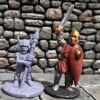Fringe Review: CORPS from ZDL's blog
Today's review is gong to be from the person I consider the James Brown of game design. Which is to say the hardest-working man in game design. His name is Greg Porter and he is the owner (and sole member) of the game producer BTRC (Blacksburg Tactical Research Center). Neither he, nor his company, are likely names you know … but you should. In his own, quiet way, Greg Porter has created some of the most interesting, most innovative, and most playable RPGs out there.
(Of course he's also created some of the most unplayable games as well…)
BTRC
BTRC as a company began as a concept in 1982. Greg Porter, dissatisfied with the state of the gaming art at the time, decided to write an RPG with the object of being realistic, integrating well all forms of combat (ranged and melee), having realistic handling of skills that didn't break at either end for novices or experts, would permit playing in any era, and, finally, would let players play themselves should they so desire. The result of this was a game, TimeLords, that was readied by the end of the year and shopped around to a variety of game publishers. Its rough draft version was fairly popular, but despite years of increasing polish he could not find a publisher who would nibble.
So he made one.
BTRC was incorporated in 1985 and TimeLords was published in 1987. The same core sytem was used in two more games: SpaceTime (1988) and WarpWorld (1991). He also published the game everybody has heard of but most people haven't played (nor even seen!): Macho Women with Guns (1988). Other games he published were Epiphany (1996), EABA (2003), Hollyworld (2005), each of which were radically different systems and ideas.
General game supplements he wrote include Guns! Guns! Guns!, a (you guessed it!) firearm design system using the TimeLords core system and Stuff!, an anything design system using the EABA core system. Both had translation notes for using the generated results in other games.
But in 1990 he published the little-known first edition of today's topic: CORPS. Which is still not the game being reviewed! But we'll be discussing it a bit before the actual review.
CORPS: The Global Conspiracy Role-Playing Game
The 1990 edition of CORPS was based on an obsession he had, summarized in the introduction to the work:
"CORPS is (to me at least), a radical departure in RPG design and philosophy. While designing it in early 1990, the thought of creating a role-playing system without the "roll" was enough to make me totally abandon other projects until I had the bare bones of the system down on paper. CORPS makes it possible to phase out over 90% of the dice rolls you would have to make in a normal system, but yet retains a level of realism that is unmatched by any other game of equal ease of play."
This is a lofty goal, and we'll see in the main review body if he accomplished it. What was interesting, though, is that he had this very intriguing idea for a game system, but then tied it to such a specific genre and setting that was not exactly a top-selling concept for the time. (There's a lot of this in BTRC history, which is very unfortunate.)
This first edition of CORPS had only 56 pages, which included both the game system (roughly 30 pages) and the setting. A year later a technology book was released adding 30 pages of equipment to the rules. And that's where it languished, generally unknown except to obsessives like this reviewer. Which is a pity because it was a sweet little system that deserved to be wider-known.
CORPS: Complete Omniversal Role-Playing System
In 1995 that chance came with the publication of the second edition of CORPS. In between the first humble publishing and the second, a large wave of "generic" games, popularized (but not invented by!) GURPS, had crashed into the shores of gaming and everybody and their dog was coming up with generic versions of their previously setting-specific games. In no particular order there was HERO, MasterBook, Tri-Stat, and just too many to mention in a review, arriving on the scene in a seemingly never-ending wave. Even game systems that weren't particularly generic were being cut away from their settings and pitched as generic games. And into this was inserted the retronymed CORPS, translated into a generic game.
Components
CORPS grew quite a bit in its second edition, going from a total of 86 pages across two books to a single, softbound book of 150 pages. In addition, quite pioneering for its time, Porter had undergone a lot of labour to make full use of the capabilities of PDF at the time, producing, in 1998, the hypertext edition which used all the advantages of PDF publication better than any other publisher was doing at the time. (This is a trend that magnified over the years to the point that EABA's books almost, but not quite, make using a full-featured PDF reader a must.) In terms of clean, crisp layout for game play, CORPS is a tour de force of design. It's a basic two-column layout (sometimes three) with a thin column separator to keep things clear. The rules make heavy use of information, alert, and "don't do that!" sidebars, colour-coded in the PDF version, that help clarify rules, establish intent, and explicitly warn against rule misapplications.
Sadly the very same features that make it a joy to use in play make it look unattractive on the shelf which I believe impacted sales. (This is a common conundrum in gaming: we buy things that look beautiful and avoid things that are actually practical.)
It should be noted that despite nearly doubling the page count, the game is not a bloated rewrite. (Anybody familiar with Porter's work will be snickering right now at the notion of him doing bloated writing. His fault lies in the other direction…) Since he was taking a near-future conspiracy game and turning it into something generic, he had to add rules for supernatural powers, different campaign styles, etc. These took space.
Characters
Characters begin being defined with six attributes: Strength, Agility, Awareness, Will, Health, and Power. The first five do what the name says on the tin. The sixth—"psychic potential"—is more nebulous whose impact varies by setting. In games with paranormal powers, a level of 2 is "average" while in games without them everybody has this set to 1. (This is a … strange design choice and in my opinion a bit of a mis-step.) Attributes range typically from 1-10, and they cost their level squared in attribute points. The number of these points (and skill points) you get depend on the style of campaign ranging from 100/50 for "real world" to 200/200 for "superheroic". (There is an interesting note in the PDF that indicates "superheroic" here does not mean 4-colour comic. And, in an interesting twist, Porter explicitly recommends HERO if you're interested in 4-colour style of play. I have to give the man props for class in recommending the competition!)
Attributes form the foundation of all skills. One quarter of your attribute (rounded to nearest whole) is your "aptitude" or starting level in all primary skills governed by that attribute. This can represent a huge skill point savings in purchasing skills, so it is not something which should be ignored.
Skills are purchased from the aforementioned skill points and … here's where things get a little unusual. There are three layers of skills: primary, secondary, and tertiary. These reflect increasing focus on decreasing breadth. The point of this becomes clearer when you understand that skills, too, cost their level squared in skill points (though primary skills are built up from aptitude at a sizable savings). These costs add up quickly. To help offset that you can start building up narrower skill areas for cheaper up to twice.
As per usual, an example makes this clearer.
Let's say your character has an Awareness of 6. That gives an aptitude in skills governed by Awareness of 2. Using, say, Liberal Arts as the primary skill, it begins at level 2. If you want a professional level (7) at Liberal Arts, you'd pay 45 points for the privilege. So for most of your skill points in a modern day campaign you'd be professional in all liberal arts. This is clearly ludicrous. It's far more likely in the real world that someone would be focused. For example only level 3 in Liberal Arts (primary), level +4 in Art (secondary), and level +3 in Sculpture (tertiary). This would cost you (3²-2²=5) for the first, 16 (!) for the second, and 9 for the third for a total of 30 points. In exchange you're a "hobbyist" grade in all liberal arts, "professional" grade in art, and "world class" in sculpture while leaving you with 20 more points to scatter around assorted broadening skills.
There are several additional modifications to skills, like "averaging" skills and "difficult" skills, but these are minor (usually literally single-paragraph) modifications and aren't worth going into detail on. One that is, however, is the tech level difference. In games without tech level differences being important this won't crop up, but in, say, a time travel game, or in a space opera game, where different levels of technology exist, the tech level difference is an added penalty in using the skill. In either direction!
This skill system has a lot of flexibility which leads to a lot of choice, but for that is more complex than most skill systems people are used to. It's not that much more complicated, but people introducing the game to new players might be doing their players a service by providing good skill mixes to speed skills selection. And indeed to that end the game provides some generic templates which GMs can model their own setting-specific ones from.
Skill trees are defined by GMs for their campaigns. Sample skill trees are provided for space opera, modern, and fantasy, but I can't conceive of any GMs worth their salt who won't be tweaking them for specific settings.
Players will rapidly find they don't have enough skill points (or attribute points) and for this, CORPS provides the '90s game omnipresent advantages/disadvantages systems. I'm not fond of this facet of '90s game design personally, but they were ubiquitous and if you're going to have one, there are far worse ones (GURPS) out there.
Another design staple of 90s games is the "Ass Saver Points" (yes, that's the real name) – a form of luck points/fate points/etc. common to many games of the era.
General System
The concept behind CORPS that makes it unique among any game I know of in the era is that it assumes characters are competent. Skill use involves comparing your skill against a difficulty. If the difficulty is less than or equal to the skill level, the skill automatically succeeds, no roll required. Anything else requires the roll of a single d10 on the formula "11 or less, -2 for every difficulty level over your skill". So with a skill of 4, difficulty 1-4 always succeeds without a die roll needed. Difficulty 5 succeeds on a 9 or less, difficulty 6 succeeds on 7 or less, etc. The only exception to this is if you're working from your attribute's aptitude level only. In that case, the highest chance of success is 9 or less. There's always a minimum of 10% chance of failure when going off of raw talent.
The system has the usual modifiers on difficulty or skill level for complementary skills, situational modifiers, etc. Skill vs. Skill rolls in adversarial or competitive circumstances where opponent skill forms the basis for difficulties. Optional rules exist that are like D&D3's "take ten" and "take twenty" rules, only predating that game by a few years. There is also an interesting, optional, but recommended, "random disaster" rule that helps make up for the system's excessive certainty in some gamers' eyes.
Combat is built up upon this foundation adding Initiative (based on the combat skill used in the round) to the mix to begin with. Initiative is counted down in "initiative segments" and each player may act on each initiative segment that is equal to or less than the skill they're using in this round with at least two points of initiative separating actions. (This makes high-skilled characters truly lethal in combat!)
In an unfortunate throwback to some of Porter's earlier designs, the movement rules are very wargames-like. Hex grids are mandatory, because among other things, movement has things like turn modes and facings being very important elements of the game. It's not difficult but it's too fiddly and anal retentive for my tastes. (We borrowed heavily from classic Traveller and its "range bands" when playing CORPS most times.)
Damage is dealt thusly: every attack has a damage value and that is applied to hit locations (selected in several possible ways) each of which has special effects for impact on performance based on damage done. Damage comes in two varieties: lethal and non-lethal, and armour can stop damage entirely, or convert lethal into non-lethal at some proportion. For example and armour value listed as 2/4 would stop two points of (any kind of) damage and would further convert 4 points of lethal damage into non-lethal.
It is in the damage rules that one of Greg Porter's deficits as a game designer comes through. The system is not actually hard. It's a bit more complicated than typical games, but after using it once it is rather intuitive. The problem is that it is explained very tersely. Porter tends not to waste words. Concepts are explained once, very precisely, but there is little redundancy and if you blink you might miss a key phrase that renders the rest of a description gibberish or, worse, you might find yourself misusing it.
However it is in the book in general that you see, too, Porter's strengths as a game designer. He believes in examples, both in the micro (single-rule) as well as the macro. And for the macro he has three pages of a combat example, taken from a real game, according to one of the PDF notes, that is well-annotated. The GM of a game should work through this one example carefully just to ensure they understand the systems involved (and how simple they really are despite the … unfortunately terse descriptions).
The game systems are VERY complete. I've only touched upon the major components, but the game, in an astonishingly small amount of space, covers explosive, vehicle combat, mass combat, environmental interaction, jobs, legal systems, tech levels, all built upon the mechanisms supplied above.
Then we get to paranormal powers.
Paranormal System
In this section, CORPS tries to replicate a power-build system as per HERO. It largely replicates the notion from HERO of effects that are modified to tweak them into exactly what is desired. One interesting feature of this system, that was later put into in subsequent versions of HERO, is that powers are colour coded green, blue, and red for increasing ability to abuse and thus derail campaigns.
The paranormal system is too large, and has too many interlocking moving parts to tease out into a simple explanation. Instead a representative example might be better: Flight. Flight, as an example from the text, is bought as the Telekinesis power. It has no range (2SP), only on self (2SP), has visible effects (2SP), drains health in use (2SP), has conscious control (5SP), and is inherent to the user (5SP). It requires a second of concentration before use (-1SP), is similar to another energy projection power the character has (-3SP), is single-purpose (-3SP), has a side effect of setting things on fire (-SP1), and has three "power multiples" to move faster (39SP). The final cost for this power is 49SP.
GM Advice
A lot of games give advice to the GM on how to run the game. CORPS is no exception. Unfortunately much of that advice is wasted space that's so boilerplate anybody who's ever even heard of an RPG these days already knows what's coming.
CORPS did it different. Sure it has some of the usual boilerplate advice on campaign style, campaign direction, etc. But then it has a few hidden gems.
How many of your RPGs have a detailed study of different kinds of role-player you might encounter and how to plan to engage them? CORPS does. How many of your RPGs give you a summary of Polti's The Thirty-Six Dramatic Situations to help you come up with more interesting plots in your game? CORPS does. CORPS also supplies guidance on dealing with problems in your game, dealing with downtime and individual side activities (blue-booking being the proposed solution), and other little gems. It's not a lot of pages long (this being a Greg Porter piece of writing) but it's chock full of little gems I've never seen in other games from before it.
Ecosystem
CORPS' first edition had a rule book, a supplement (and I have vague memories of there being an adventure published for it) and nothing else. The second edition was far more successful. It had the core rule book, naturally, but also had a (very complete) vehicle design system provided. A third-party publication, made with the blessing of Porter, acts as a semi-official rules expansion. Two settings (Dreamtime and TimeLords, a CORPS conversion of BTRC's first game) were released. A book called Apocalypse containing 13 end-of-world scenarios for gaming was also provided (and is one of my favourite such supplements of all time). Even a "nutshell edition" of CORPS was released as a free game which provides the key systems of the game in four pages so that players can try out the game concepts before playing the full system.
Where the first edition languished in bargain bins and memories of people like me, the second edition saw some action and got decent reviews. It was not, however, successful enough to keep the line alive and was later replaced by BTRC's EABA line.
Conclusion
I have mixed feelings about CORPS overall. I've had a lot of good times with it, especially as a replacement for assorted Traveller game systems, and I think it is overall an admirable game. In most respects it has a good balance between complexity and being playable, and it has some genuinely innovative things that make me keep coming back to it as a generic game of the older school. (Increasingly it is replaced, however, by newer-school games with an entirely different focus like Spark and FATE.)
But…
Some of its missteps are very annoying, most notably how the combat system feels like a wargame, not like an RPG. The wargamey elements can be ignored (and we always did), but then the system has a few holes that are hard to plug because the game design assumes the use of tactics that can't be done without the wargamey approach.
But...
What it does right is very right and further, for a 150 page book, it is astonishingly complete.
You can see how my feelings kind of twist up.
What I will say is that CORPS doesn't cost much, and even if you don't use it directly, it has lots of interesting ideas that might be worth cribbing for other games.
















The Wall